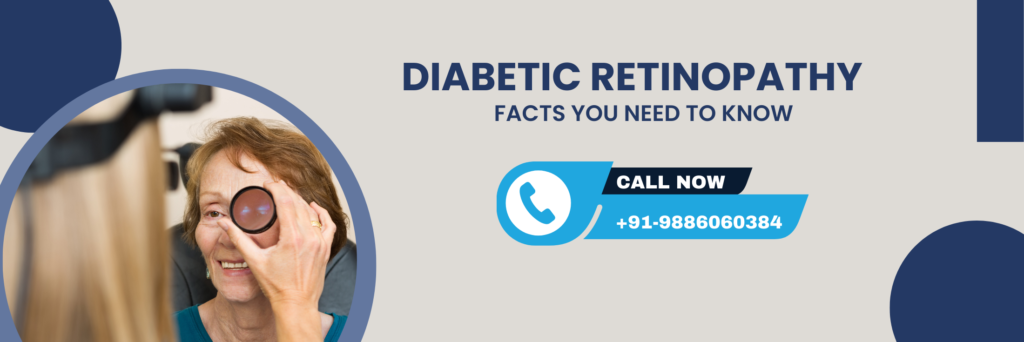About Diabetic Retinopathy:
Diabetic retinopathy affects the blood vessels that can be seen on the back of your eye. Diabetes is a disorder of glucose metabolism and it is caused by either too much insulin, too little insulin, or the cells becoming resistant to insulin. The article discusses diabetic retinopathy, signs and symptoms of diabetes, complications due to this disease, and treatment options available to treat diabetic retinopathy.
What is Diabetic Retinopathy?
Diabetic retinopathy is the one of the serious region for diabetes, that can be lead to blindness in adults as well as ages peoples. Diabetic retinopathy can cause when diabetes damages the blood vessels in the retina, the light-sensitive tissue at the back of the eye.
Diabetic retinopathy often has no early warning signs. That’s why people with diabetes should have a comprehensive dilated eye exam at least once a year. A dilated eye exam is the best way to detect diabetic retinopathy in its early stages, when it can be treated more effectively.
If you have diabetic retinopathy, your treatment will depend on how severe it is. Early stages of diabetic retinopathy may not need treatment other than close monitoring by your best ophthalmologist or optometrist. More advanced stages may require laser surgery , injections of drugs into the eye, or surgery to remove the damaged portion of the retina.
What are the Symptoms of Diabetic Retinopathy?
There are two main types of diabetic retinopathy: early stage and advanced stage. Early stage diabetic retinopathy has no symptoms and can only be detected through a comprehensive eye exam. Advanced stage diabetic retinopathy, on the other hand, can cause a number of symptoms, including:
-Blurry vision
-Floaters or spots in your vision
-Fluctuations in vision
– Difficulty seeing at night
– Progressive loss of vision
How Can You Prevent Diabetic Retinopathy?
There are a few things you can do to help prevent diabetic retinopathy, or at least slow its progression. Maintaining good control of your blood sugar levels is the most important thing you can do. This means keeping your A1C levels below 7%. You should also have your blood pressure checked regularly and keep it under control. If you smoke, quitting smoking is also important.
In addition to these lifestyle changes, there are also some medical treatments that can help prevent diabetic retinopathy or at least slow its progression. These include laser therapy, which can help shrink abnormal blood vessels in the eye, and intravitreal injections, which can help reduce inflammation and improve blood flow to the retina.
How Do Doctors Diagnose Diabetic Retinopathy?
When it comes to diagnosing diabetic retinopathy, best eye doctors will usually start by conducting a comprehensive eye exam. This will usually involve the use of specialised equipment and techniques in order to get a clear view of the retina – the light-sensitive layer of tissue at the back of the eye.
If diabetic retinopathy is suspected, doctors may also recommend further tests, such as an angiography. This is where dye is injected into the bloodstream and then pictures are taken of the blood vessels in the retina.
Once diabetic retinopathy has been diagnosed, doctors will then discuss treatment options with patients. In some cases, no treatment may be necessary if the condition is mild and not causing any symptoms. However, if the condition is more severe, treatment may be necessary in order to prevent vision loss.Also Check: How Much Does Cataract Eye treatment Cost in Bangalore
How Can I Treat Diabetic Retinopathy?
If you have diabetes, you may be at risk for developing a serious complication called diabetic retinopathy. This condition can damage the blood vessels in your retina, the light-sensitive tissue at the back of your eye. In adults blindness can be caused by Diabetic retinopathy so we have to be careful and need regular check-up with doctor.
There is no cure for diabetic retinopathy, but early diagnosis and treatment can help slow its progression and prevent vision loss. If you have diabetes, it’s important to have regular comprehensive dilated eye exams so that any changes in your retina can be detected early.
If you develop diabetic retinopathy, there are several treatments available to help slow its progression and preserve your vision. These include:
- Laser surgery: A laser is used to make small burns around the leaking blood vessels in your retina, which helps to seal them off. This procedure is often done in several sessions, spaced a few weeks apart.
- Injections: Certain medications can be injected into the space around your eye to help reduce inflammation and prevent new blood vessels from forming. These injections are usually given every four to eight weeks.
- Surgery: In some cases, surgery may be needed to remove abnormal blood vessels from your retina or to relieve pressure on it caused by fluid buildup.
Also Check: How Much Does Lasik Eye treatment Cost in Bangalore
Conclusion
Diabetic retinopathy is a serious complication of diabetes that can lead to vision loss. It is important to be aware of the risk factors for diabetic retinopathy and to get regular eye exams so that it can be detected early and treated. With proper treatment, many people with diabetic retinopathy are able to maintain good vision. If you want the best eye doctors for diabetic or laser treatment or cataract treatment , then contact the Seedi Eye Care Centre – which provides complete eye care solutions in Bangalore.




